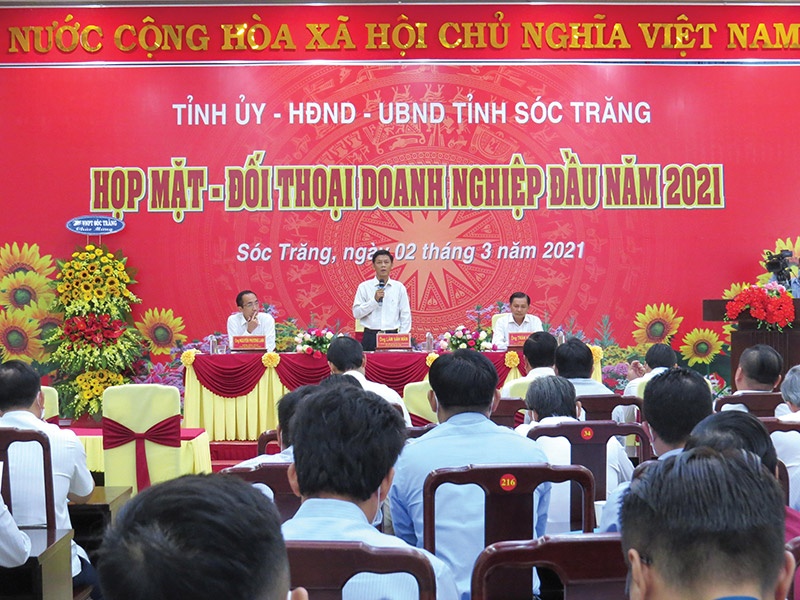Soc Trang province looks to prosper by leaps and bounds
 |
| Soc Trang leaders have been promoting the benefits of pouring money into the province |
One of the most challenging, long-standing impediments to attracting high-quality investment to Soc Trang and other provinces in the region has been a long-lasting lack of adequate transport infrastructure, shipping ports, and logistics services.
This stumbling block could be eliminated as the central government implements a series of projects on critical transport infrastructure, thus building a seamless inter-regional traffic flow, which will act as a catalyst for growth across the Mekong Delta and Soc Trang.
In addition to the eastern part of the North-South Expressway, the first phase of Chau Doc-Can Tho-Soc Trang Expressway (around 188km long) has just been submitted to the National Assembly. The preliminary total expense of the project is approximately $1.94 billion.
When finished, this will be one of three major horizontal axis expressways in the Mekong Delta, contributing to the development of the Northwest-Southeast Economic Corridor, which is the biggest and most significant transport route in the heart of the region.
Furthermore, it will serve as a highway linking and boosting trading activities between Vietnam and Cambodia, particularly when construction of Tran De Seaport is finished. The project is scheduled to begin construction in 2023 and be finished in 2025.
The Ministry of Transport also requested some adjustments, including not using Japan’s official development assistance to construct Dai Ngai Bridge along the National Highway No.60 crossing the Hau River. In addition, experts believed that various favourable procedures have been implemented to ensure that the project is finished by 2026.
Dai Ngai Bridge is envisaged to unlock the full potential of the National Highway No.60, thus boosting transportation capacity and facilitating buoyant trading activities in the Mekong Delta.
Additionally, the Tra Vinh-Soc Trang-Bac Lieu coastline road project spans around 53.5km, and is expected to be operational in the next five years.
Tran De Seaport, in particular, has been included in the prime minister’s master plan for the development of Vietnam’s seaport system between 2021 and 2030, with a view to 2050. Soc Trang is collaborating with a consulting firm to expedite the production of comprehensive planning, and the development of land, water regions, and the province’s seaport.
The proposed site for the construction of Tran De Seaport is the centre of the lower Hau River, linking inland waterways and roadways.
Soc Trang concentrated its efforts in recent years on mobilising financial resources to embark on a wide range of major traffic projects to establish an inter-regional transportation link system and formulate a driving force for socioeconomic development in the area.
For example, Mac Dinh Chi Bridge with the total investment of $12 million, is a key link between Soc Trang city with the salt-water prevention dyke system and national defense route in order to save ships in Tran De and expand the province’s coastal economic zone, Soc Trang needs a dike line and a road.
The construction of the east-west economic development axis running through Soc Trang last January, with the total investment of around $87 million, played an essential part in connecting Soc Trang with neighbouring provinces like Hau Giang, Bac Lieu, and Ca Mau.
In addition, the province has begun crucial work on Nguyen Van Linh and Vanh Dai II bridges, with the total investment of $15.2 million.
Soc Trang has also authorised the execution of other transport infrastructure projects for the 2021-2025 period. Additional efforts would be placed on the ongoing provincial highways and other urban trunk highways. The budget for this tenure is estimated to be around $434.8 million.
 |
What the stars mean:
★ Poor ★ ★ Promising ★★★ Good ★★★★ Very good ★★★★★ Exceptional
Related Contents
Latest News
More News
- Strengthening supply chains through trade promotions and customs reform (December 24, 2025 | 14:00)
- PM orders investment model for North–South high-speed rail (December 22, 2025 | 17:43)
- LS Eco Energy to invest in Vietnam rare earth sector (December 22, 2025 | 17:31)
- Government moves to establish International Financial Centre (December 21, 2025 | 21:00)
- Vietnam's IFC to target global investment flows (December 21, 2025 | 18:00)
- Two national hospitals expand capacity with new facilities (December 20, 2025 | 09:00)
- Ha Tinh breaks ground on major Vingroup industrial and energy projects (December 19, 2025 | 18:24)
- EVN launches major power infrastructure projects nationwide (December 19, 2025 | 18:17)
- VAL inaugurates second production line to meet domestic animal feed demand (December 19, 2025 | 16:37)
- Sun Group pioneers urban tram system in Phu Quoc (December 19, 2025 | 15:00)

 Tag:
Tag:






















 Mobile Version
Mobile Version